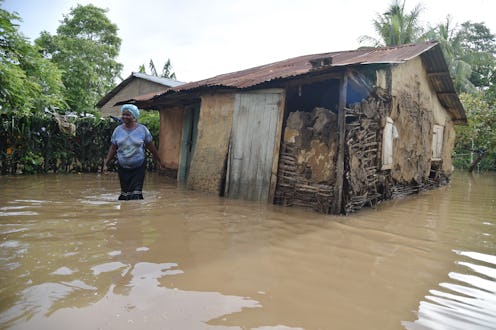News
Hurricane Maria Has Already Begun Battering The Caribbean

The 2017 hurricane season has been unusually brutal, but it's not letting up any time soon: Although Irma and Harvey have come and gone, Maria is in full force. What began as a tropical storm strengthened to a Category 5 hurricane by Monday, with winds of up to 160 miles per hour. It's no longer a question of when Hurricane Maria will hit: The storm made landfall in Dominica on Monday evening, and is expected to hit the U.S. Virgin Islands on Tuesday.
In an indication of just how serious this storm is, Dominica's Prime Minister wrote on Facebook Monday that the hurricane had destroyed the roof of his home, placing him "at the complete mercy of the hurricane." He wrote seven minutes later that he had been rescued from his home, which flooded.
The National Hurricane Center has issued hurricane warnings for many islands in the Caribbean, including the U.S. and British Virgin Islands, Puerto Rico, Guadeloupe, St. Kitts, Nevis, Montserrat, Culebra, and Vieques. Hurricane watches, meanwhile, are in effect in Saba, St. Eustatius, St. Martin, St. Barthelemy, Anguilla, and Isla Saona to Puerto Plata.
A hurricane warning means that hurricane conditions are expected in a given location, while a hurricane watch means that such conditions are possible but not necessarily expected. Other islands in the region are under tropical storm warnings or watches.
As is often the case with hurricanes, one of the greatest threats Maria poses is storm surge, which refers to the excess water that a hurricane drags from the ocean as it approaches a shoreline. Storm surge is responsible for much of the flooding that hurricanes bring, and according to the National Hurricane Center, Maria could bring storm surge of up to 9 feet to Puerto Rico and the U.S. Virgin Islands.
Many of the Caribbean islands in Maria's path are still recovering from Hurricanes Harvey and Irma, which hit the region in late August and September. In St. Martin, more than two-thirds of homes were rendered inhabitable on account of Irma, according to the BBC, with no gas, electricity, or running water available. The island of Barbuda, in which a tropical storm warning is currently in effect, was devastated by Irma and is now completely unpopulated as the result of an island-wide evacuation.
President Donald Trump declared a state of emergency in Puerto Rico and the U.S. Virgin Islands on Monday, and U.S. Virgin Islands Gov. Kenneth Mapp suspended all Irma recovery efforts in order to allocate resources toward Maria preparation. Puerto Rican Gov. Ricardo Rosselló has declared a state of emergency on the island, which hasn't faced direct impact from a Category 5 hurricane in over 85 years.
"We want to alert the people of Puerto Rico that this is not an event like we've ever seen before," Rosselló said on Monday. "It will essentially devastate most of the island."
Puerto Rico largely escaped the wraths of Hurricanes Harvey and Irma, and opened around 450 emergency shelters for refugees from places that were hit harder by the twin storms. Those shelters will remain open in preparation for Maria's impact, USA Today reported. Additionally, officials from the Federal Emergency Management Agency (FEMA) who were deployed to assist with Irma and Harvey recovery efforts will remain in Puerto Rico to help prepare for Maria.
Rosselló noted that, although he may have disagreed with the Trump administration on certain ideological issues, the federal government has been extremely helpful in helping the island prepare for Maria.
"There can be many other areas where we differ on public policy,” Rosselló told USA Today, “but I have to say the response from FEMA [to Maria] and the federal response has been phenomenal.”